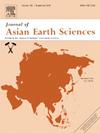Apatite-bearing mantle xenoliths in Early Cretaceous basalts: Implications for geochemical modifications and carbon cycling in eastern North China Craton
IF 2.7
3区 地球科学
Q2 GEOSCIENCES, MULTIDISCIPLINARY
引用次数: 0
Abstract
The eastern North China Craton (NCC) has undergone multistage lithospheric modifications through the recycling of subducted crustal materials. However, the mechanisms underlying the formation of carbon-rich domains in the subcontinental lithospheric mantle during the Late Mesozoic evolution remain poorly understood. Here, we report the petrological and in-situ geochemical characteristics of apatite-bearing mantle xenoliths from the Early Cretaceous Fangcheng basalts. The presence of near-equilibrium fluorapatites with olivines and clinopyroxenes along with a high proportion of clinopyroxenes and abundant CO2 fluid inclusions in the wehrlites and olivine clinopyroxenites indicates the occurrence of carbonatite metasomatism. The geochemical compositions of the apatites show relatively high abundances of F (∼2.78 wt%) and Sr (∼3842 ppm), low Sr/Y (<52) and high (La/Yb)N (∼215) ratios, resembling apatite crystallizing from carbonatite magmas. Clinopyroxenes exhibit low Al and Ti concentrations and are characterized by low Ti/Eu ratio (517–1867) and high (La/Yb)N (13–15) and Ca/Al ratios (7–9), consistent with geochemical trends associated with carbonatite metasomatism. Elevated Li concentration (>3 ppm) and low V/Sc ratio (<3) in olivines suggest the contribution of recycled crustal components to the peridotitic lithosphere. Additionally, highly enriched Sr-Nd isotopes reported in the Fangcheng basalts support the inference that Fangcheng wehrlites were metasomatized by carbonatite magmas derived from subducted carbonated pelites before being incorporated into the Early Cretaceous basaltic magmas. This metasomatic process serves as a crucial mechanism for lithospheric modifications and plays a key role in regional carbon cycling in the southeastern NCC, encompassing the subduction of carbonate-bearing continental crusts and subsequent devolatilization through mantle-derived volcanism.

求助全文
约1分钟内获得全文
求助全文
来源期刊

Journal of Asian Earth Sciences
地学-地球科学综合
CiteScore
5.90
自引率
10.00%
发文量
324
审稿时长
71 days
期刊介绍:
Journal of Asian Earth Sciences has an open access mirror journal Journal of Asian Earth Sciences: X, sharing the same aims and scope, editorial team, submission system and rigorous peer review.
The Journal of Asian Earth Sciences is an international interdisciplinary journal devoted to all aspects of research related to the solid Earth Sciences of Asia. The Journal publishes high quality, peer-reviewed scientific papers on the regional geology, tectonics, geochemistry and geophysics of Asia. It will be devoted primarily to research papers but short communications relating to new developments of broad interest, reviews and book reviews will also be included. Papers must have international appeal and should present work of more than local significance.
The scope includes deep processes of the Asian continent and its adjacent oceans; seismology and earthquakes; orogeny, magmatism, metamorphism and volcanism; growth, deformation and destruction of the Asian crust; crust-mantle interaction; evolution of life (early life, biostratigraphy, biogeography and mass-extinction); fluids, fluxes and reservoirs of mineral and energy resources; surface processes (weathering, erosion, transport and deposition of sediments) and resulting geomorphology; and the response of the Earth to global climate change as viewed within the Asian continent and surrounding oceans.
 求助内容:
求助内容: 应助结果提醒方式:
应助结果提醒方式:


